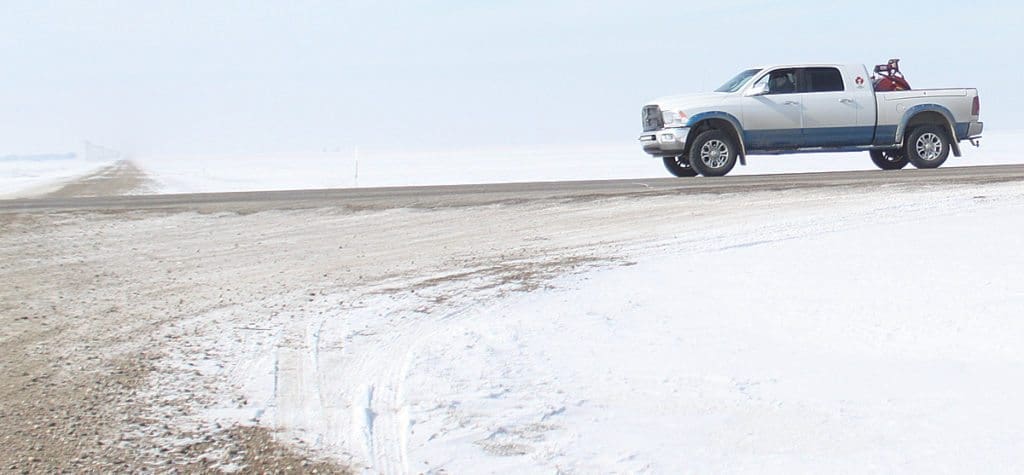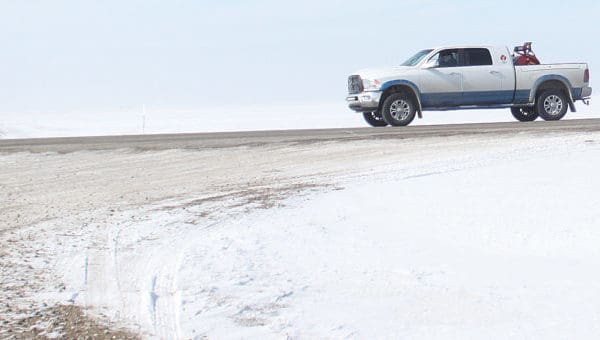
A vehicle passes an intersection on Highway 21 just north of Kindersley that doesn’t have any traffic signs.
Kenneth Brown
of The Crossroads
A citizen has raised a concern about the lack of traffic signs where municipal roads intersect provincial highways. People could ask for signs to be put up.
Wayne Whitney, a trucker who operates a small oil hauling business, has been trucking in the west central region for several years. Whitney is an advocate for road improvements in the area. He pointed to a concern with a lack of road signs along a busy provincial highway.
He noted that there is an intersection where a municipal grid road crosses Highway 21 just north of Kindersley, and there are no stop or yield signs at the intersection. There are oil tanks along the municipal grid road east of the highway, so the road is used by the oil and gas industry.
The concerned citizen said he believes it is a safety concern because if visibility was badly reduced by snow or fog, a person who is not familiar with the road and intersection could end up putting themselves in danger on the busy highway.
[emember_protected for=”2″ custom_msg=’For more on this story, please see the May 11 print edition of The Cross Roads.’]
According to Steve Shaheen, a senior communications consultant with the ministry of highways and infrastructure, said traffic signs at intersections along provincial highways are under the ministry’s jurisdiction. Traffic signs at intersections where two municipal roads meet are under a rural municipality’s jurisdiction, Shaheen explained.
If an intersection at a provincial highway has no signs, it could mean there was a sign an it has fallen down or there were no signs in the first place. If a sign has fallen down or if it was knocked over, it could be reported to the ministry, Shaheen said.
He noted that ministry workers often report when a sign has fallen or been knocked down, but the report could also come from the public. If there are no signs at an intersection at all and people believe there should be signs, there are ways of getting the ministry to erect signs.
Shaheen said people could make a request to add stop or yield signs at an intersection along a provincial highway, but the requests often come from rural municipalities. The sign crew from the ministry would first investigate to see if there was previously a sign at the location.
If there was a sign, it would be replaced. If there were no signs, the ministry’s technical group would handle the request to add signs. The technical group would work to determine if signs are warranted and the ministry would respond accordingly. The requests are “typically” made by rural municipalities, Shaheen said.
Glenda Giles, administrator for the RM of Kindersley, said people could contact the municipality if they believe traffic signs are warranted at an intersection on a provincial highway where there are no existing signs.
However, she said the municipality is not going to make a request to the ministry if only one person is asking for signs to be put up at the intersection. Council members could assess the need, themselves, but there have not been any requests for signs along provincial highways from the public in recent history.
She noted that municipalities are encouraged not to erect traffic signs on all of their roads. Giles said if one of the municipalities signs has fallen down, the municipality could be liable in the event of a collision. All traffic signs in a municipality are accounted for in a bylaw.
“It’s not just that we can stick them up wherever we feel like it,” Giles added, recognizing that all road signs have to be approved by the ministry and the liability increases if the municipality knows a sign is missing at an intersection where a collision occurs.

